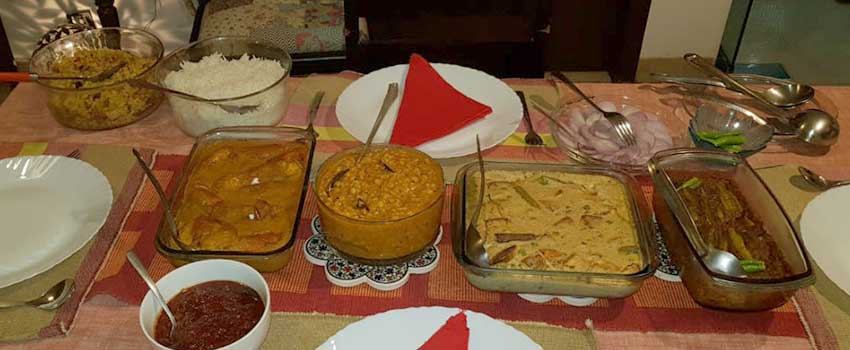
Date: 9 June 2018
Venue: Vasant Kunj
We are all different – Yin and Yang. Together we complete the picture. Pedantic as it sounds that’s what makes India unique. Sitting in India rarely do we get to experience the sheer culinary diversity that each region of our beautiful country has to offer. Restaurants have a populist way of doing things which may be far from authentic or event enjoyable. And yet that is what passes of as the cuisine. One of us, a huge fan of Sarson ka Saag at Punjabi restaurants has done a cold turkey to ordering this dish after having the home cooked version. The home version is mild, wholesome, lot more fibre and texture and lot less oil. The Bengali Potol Posto (parwal cooked in poppy seed paste) is a delicacy that is never cooked properly in restaurants. Regrettably, in a bid to make stuff move faster, restaurants go over the top with oil, spice and cream just don’t serve the right thing.
Talking about Bengali food, it somehow is never right when served at restaurants including, not taking names, but fine dining places. Bengali food in Delhi or Bengali food in Gurgaon is tempered to some vague notion of local tastes so it is an adulterated version of the authentic. So what does one do if he wants to try the real thing? Home chef Moushumi Moitra at Vasant Kunj has come up with a great idea. She has opened her home to diners in small batches (4 to 6 people) for Bengali meals home-style!
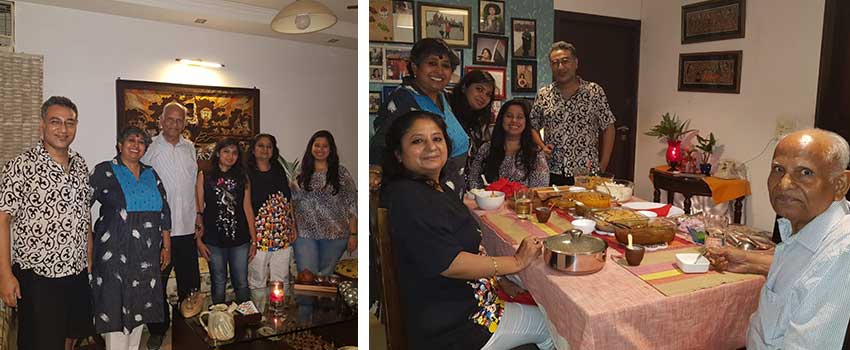
We had signed up last weekend for dinner and it was a table for 4. She keeps a beautiful house and we were welcomed with chops and raw mango sherbet with Gandhoraj lime (Bengali version of kaffir lime). It was a sit down dinner and Moushumi personally served all the guests providing little trivia about the dishes. It was good to see that vegetarian and non-vegetarian dishes were balanced in the curated meal.
Apparently a Bengali meal starts with light dishes and climaxes with rich vegetarian or non-vegetarian items. There were chholar dal (chana dal Bengali style), potoler dorma (parval stuffed with khoya cooked with spices) and paneer with paratha. Then came the non-vegetarian dishes – golda chingri (tiger prawn) malaikari cooked in coconut extract and kosha mangsho (Bengali mutton curry). There was plain rice and sweet pulao with dry fruits as carbs. We have not had this fragrant pulao before. It balanced the spices of the red meat dish. Pulao and kosha mangsho are a combo in Bengali cuisine. This was a lot of food and we were completely stuffed by the end of the main course.
The main course was followed by the quintessential Bengali mango-papad chutney. This is somewhat thick sweet-tangy chutney, a palate cleanser, bridging the main course and desserts. We love this chutney in any form and couldn’t wait to have it. The dessert comprised rosogolla and mishti doi (Bengali sweet yoghurt) in clay cups. The smell of the cup had infused into the yoghurt and added a certain sweet earthy flavor to this item. Yoghurt is often served after a heavy Bengali meal since it acts as a digestive. And oh yeah – we needed something like that!
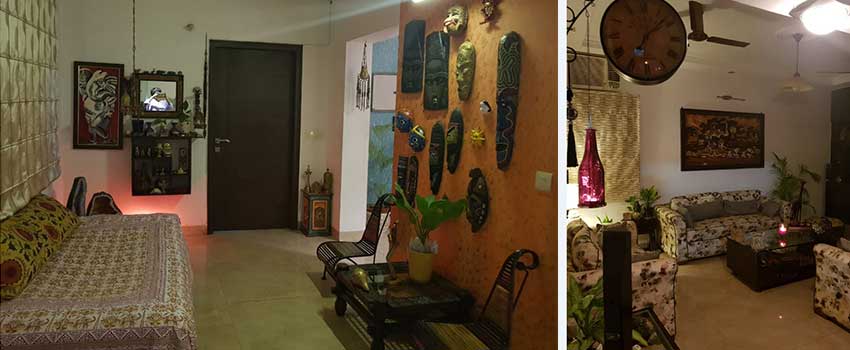
Dining at fancy restaurants are often impersonal affairs, tedious at times. The home meal was a cosy affair, no din from the bawling child or the over enthusiastic group of old friends on the next table. We just focused on the meals and the civil interaction with the other diners did not come in the way. It is like a secret restaurant – only with an inside knowledge. When we asked Moushumi as to how did she get this idea, her explanation was simple. She said she liked entertaining and given that her daughter is a grown-up and her diplomat husband is posted abroad, she had time on hand. She decided to fuse her passion for cooking and meeting new people which led to this concept. No, she doesn’t have stranger anxiety, although there are some basic rules like the dinner should start by 8 pm and guests should leave by 10 pm latest 10:15. Simple civilities we say. In fact, she also does lunches over weekends. You could connect with her at 9560940750 to book your slot.
We loved the home dining experience. Not only was the home cooked Bengali meal healthier (no extra oil, spice or chilies thank you!), but also, since the food was home cooked, we could have more without any repercussions the next morning. What we had here was a far cry from what we have at Bengali restaurants, which, we always suspected, wasn’t right. Bonus -it was a slice of Bengali culture and an orientation to do a holiday in Bengal. All the best to Moushumi on her novel endeavour.
Given that Delhi NCR is a melting pot of cultures, we do wish other home chefs are inspired by Moushumi and start polishing their own pots for us.


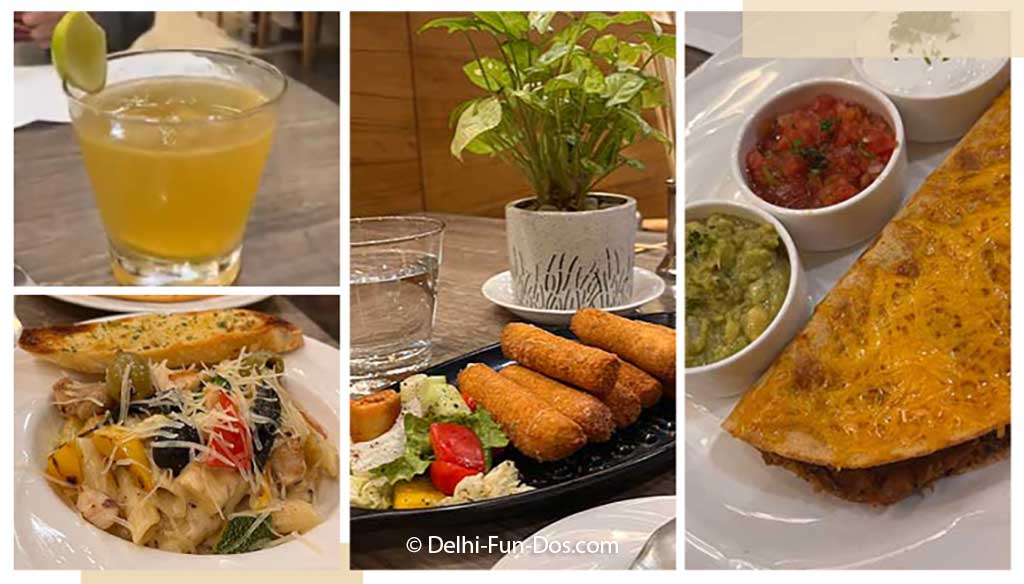
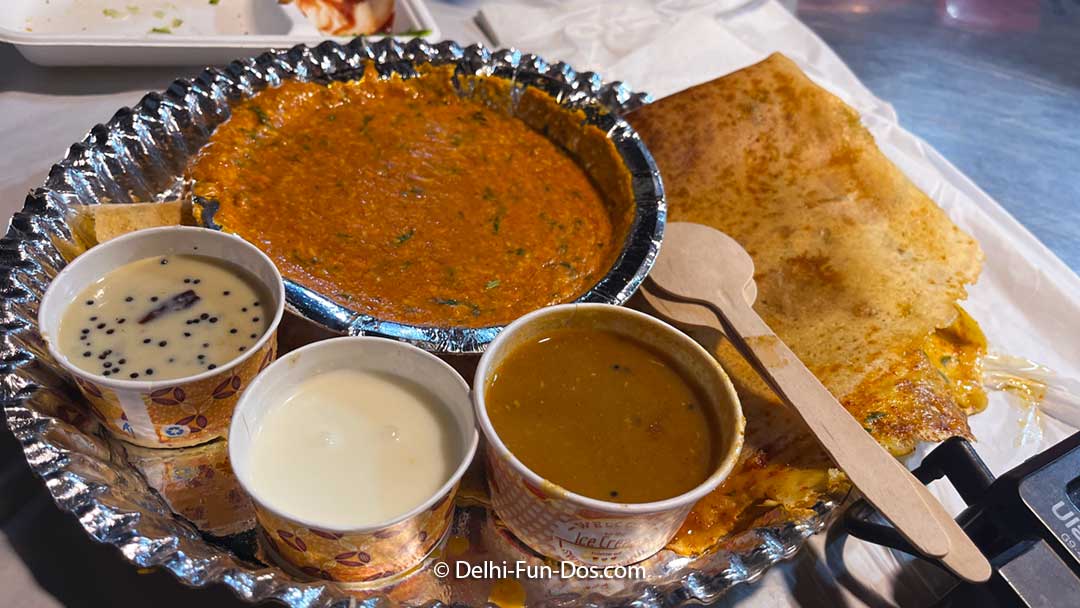
Nothing can beat a home cooked meal.
Looks delicious